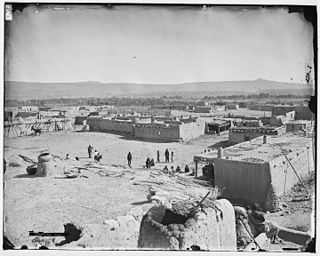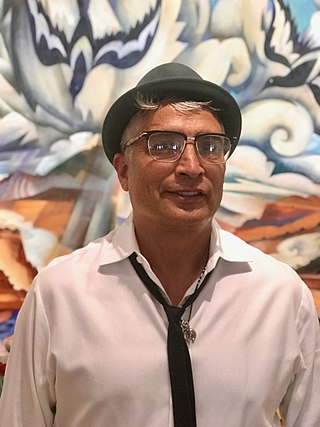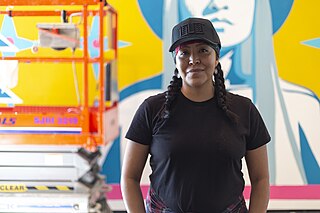
Cochiti is a census-designated place (CDP) in Sandoval County, New Mexico, United States. A historic pueblo of the Cochiti people, one of the Keresan Nations, it is part of the Albuquerque Metropolitan Statistical Area. The population was 528 at the 2010 census. Located 22 miles (35 km) southwest of Santa Fe, the community is listed as a historic district on the National Register of Historic Places.

Kewa Pueblo is a federally-recognized tribe of Native American Pueblo people in northern New Mexico, in Sandoval County southwest of Santa Fe. The pueblo is recorded as the Santo Domingo Pueblo census-designated place by the U.S. Census Bureau, with a population of 2,456 at the 2010 census.

The Institute of American Indian Arts (IAIA) is a public tribal land-grant college in Santa Fe, New Mexico, United States. The college focuses on Native American art. It operates the Museum of Contemporary Native Arts (MoCNA), which is housed in the historic Santa Fe Federal Building, a landmark Pueblo Revival building listed on the National Register of Historic Places as Federal Building. The museum houses the National Collection of Contemporary Indian Art, with more than 7,000 items.
Mateo Romero is a Native American painter. He was born in Berkeley, California, and is a member of the Cochiti Pueblo.

Roxanne Swentzell is a Santa Clara Tewa Native American sculptor, ceramic artist, Indigenous food activist, and gallerist. Her artworks are in major public collections and she has won numerous awards.

Linda Lomahaftewa is a Hopi and Choctaw printmaker, painter, and educator living in Santa Fe, New Mexico.

Bob Haozous is a Chiricahua Apache sculptor from Santa Fe, New Mexico. He is enrolled in the Fort Sill Apache Tribe.
Lisa Holt and Harlan Reano are a husband-and-wife team of Pueblo potters and artists from northern New Mexico. They have been making pottery together in 1999, they use traditional Cochiti pottery techniques and create modern work.
Virgil Ortiz is a Pueblo artist, known for his pottery and fashion design from Cochiti Pueblo, New Mexico. Ortiz makes a variety of pottery, including traditional Cochiti figurative pottery, experimental figurative pottery, traditional pottery vessels. His clothing and jewelry designs are influenced by traditional Native American pattern and aesthetics. He is best known for his edgy pottery figures, his contemporary take on the traditional Cochiti pottery figures (monos) from the late 1800s.
Nathan Begaye (1969–2010) was a Native American ceramics artist of Navajo and Hopi descent.

Tonita Peña born as Quah Ah but also used the name Tonita Vigil Peña and María Antonia Tonita Peña. Peña was a renowned Pueblo artist, specializing in pen and ink on paper embellished with watercolor. She was a well-known and influential Native American artist and art teacher of the early 1920s and 1930s.
Lloyd Henri Kiva New was a pioneer of modern Native American fashion design and a cofounder and president emeritus of the Institute of American Indian Arts (IAIA) in Santa Fe, New Mexico.
Cara Romero is an American photographer known for her digital photography that examines Indigenous life through a contemporary lens. She lives in both Santa Fe, NM and the Mojave Desert. She is of Chemehuevi descent.

Native American fashion is the design and creation of high-fashion clothing and fashion accessories by Native Americans in the United States. This is a part of a larger movement of Indigenous fashion of the Americas.

Rick Dillingham (1952–1994) was an American ceramic artist, scholar, collector and museum professional best known for his broken pot technique and scholarly publications on Pueblo pottery.
Christine McHorse, also known as Christine Nofchissey McHorse, was a Navajo ceramic artist from Santa Fe, New Mexico.
Juanita Inez Ortiz, also known as Inez Ortiz was a Native American Cochiti Pueblo artist, specializing in pottery. She is of the Herrera family of Pueblo potters in New Mexico, whose work is often found in art collections and in art museums. She was from the Cochiti Pueblo in Cochiti, New Mexico.
Laurencita R. Herrera (1912–1984) was a renowned Native American Cochiti Pueblo artist, specializing in traditional Cochiti figurative pottery called storytellers and her pottery vessels. She is of the Herrera family, a renowned family of Pueblo potters in New Mexico, whose work is often found in art collections and in art museums. She was an actively making pottery between the 1930s through the 1970s and is known as one of the, "finest Cochiti potters of that era".

Tony Abeyta is a contemporary Navajo Diné artist living between Berkeley California and Santa Fe, New Mexico. Abeyta's work is most well known as mixed media paintings and oil landscapes of the American southwest. His subject matter include the New Mexico landscape, ancestral Navajo iconography and American Modernism

Lynnette Haozous a Native American painter, printmaker, jeweler, writer, and actor. She is an enrolled member of the San Carlos Apache Tribe and of Chiricahua Apache, Navajo, and Taos Pueblo ancestry. Haozous works in acrylics, watercolors, spray paint, jewelry, screen-printing, writing, and acting on stage and in film. She is known for her murals and uses a blend of art and advocacy to bring attention to social conditions and injustices.










